Pharmacokinetics and Pharmacology Report: Perindopril and Aspirin
VerifiedAdded on 2021/04/17
|8
|2324
|31
Report
AI Summary
This report provides a detailed comparative analysis of perindopril and aspirin, focusing on their pharmacokinetics, pharmacodynamics, and implications for nursing practice. It begins with an introduction to the drugs, highlighting their uses in cardiovascular conditions and pain management, respectively. The report then delves into a comparison of the two drugs, examining their absorption, metabolism, and excretion processes. Key differences in bioavailability, adverse reactions, and half-lives are discussed. The pharmacodynamic effects of each drug are also explored, including perindopril's ACE inhibition and aspirin's antiplatelet action. A critical analysis of the implications for registered nurses is presented, covering patient monitoring, dosage adjustments, and education. The report emphasizes the need for careful assessment of patients, including those with diabetes, renal complications, and those at risk of cardiovascular events. Nurses are advised to monitor vital signs, laboratory values, and potential adverse effects. The conclusion summarizes the key findings, emphasizing the importance of systematic monitoring and evaluation to minimize clinical complications. References to supporting literature are included.
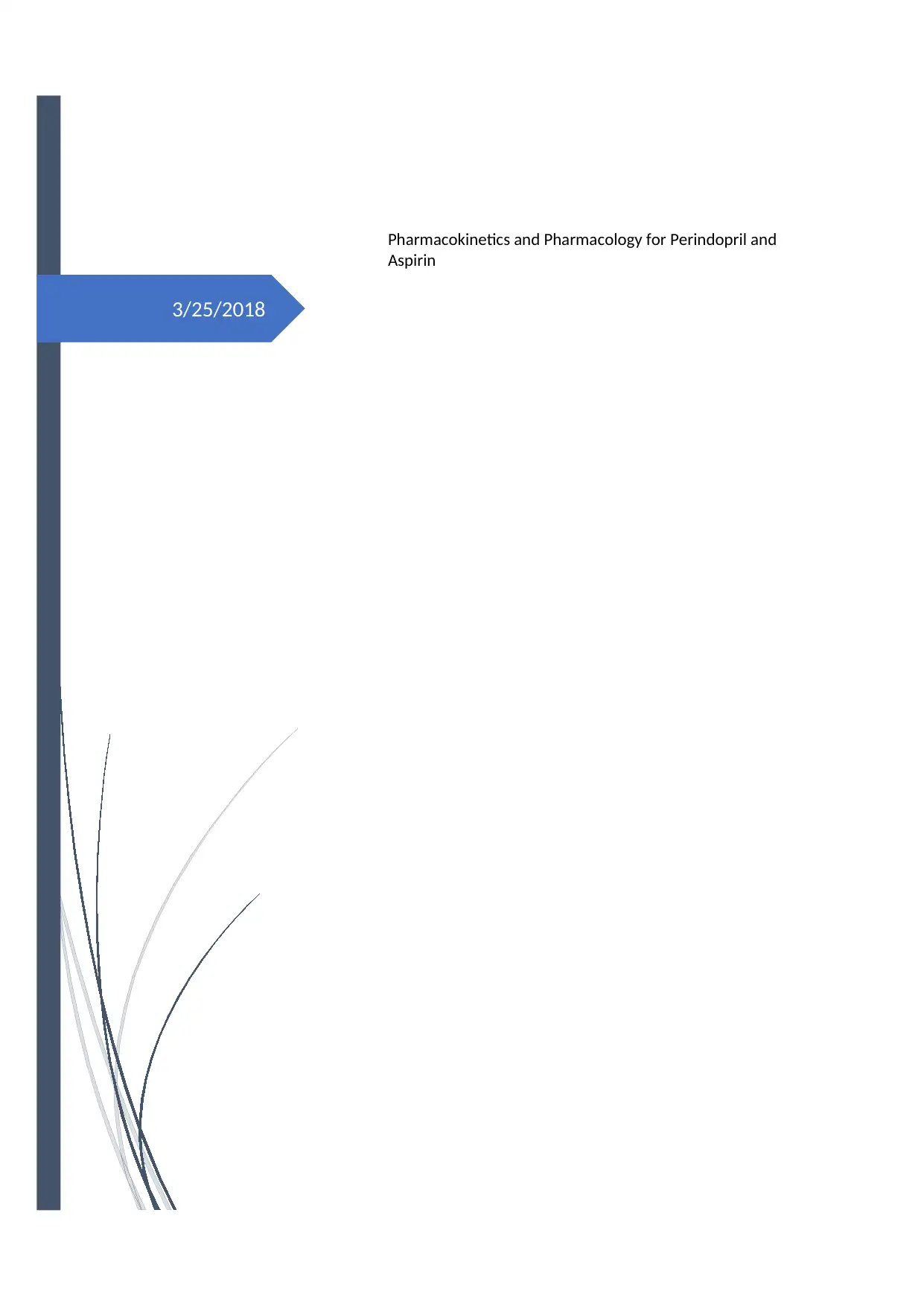
3/25/2018
Pharmacokinetics and Pharmacology for Perindopril and
Aspirin
Pharmacokinetics and Pharmacology for Perindopril and
Aspirin
Paraphrase This Document
Need a fresh take? Get an instant paraphrase of this document with our AI Paraphraser
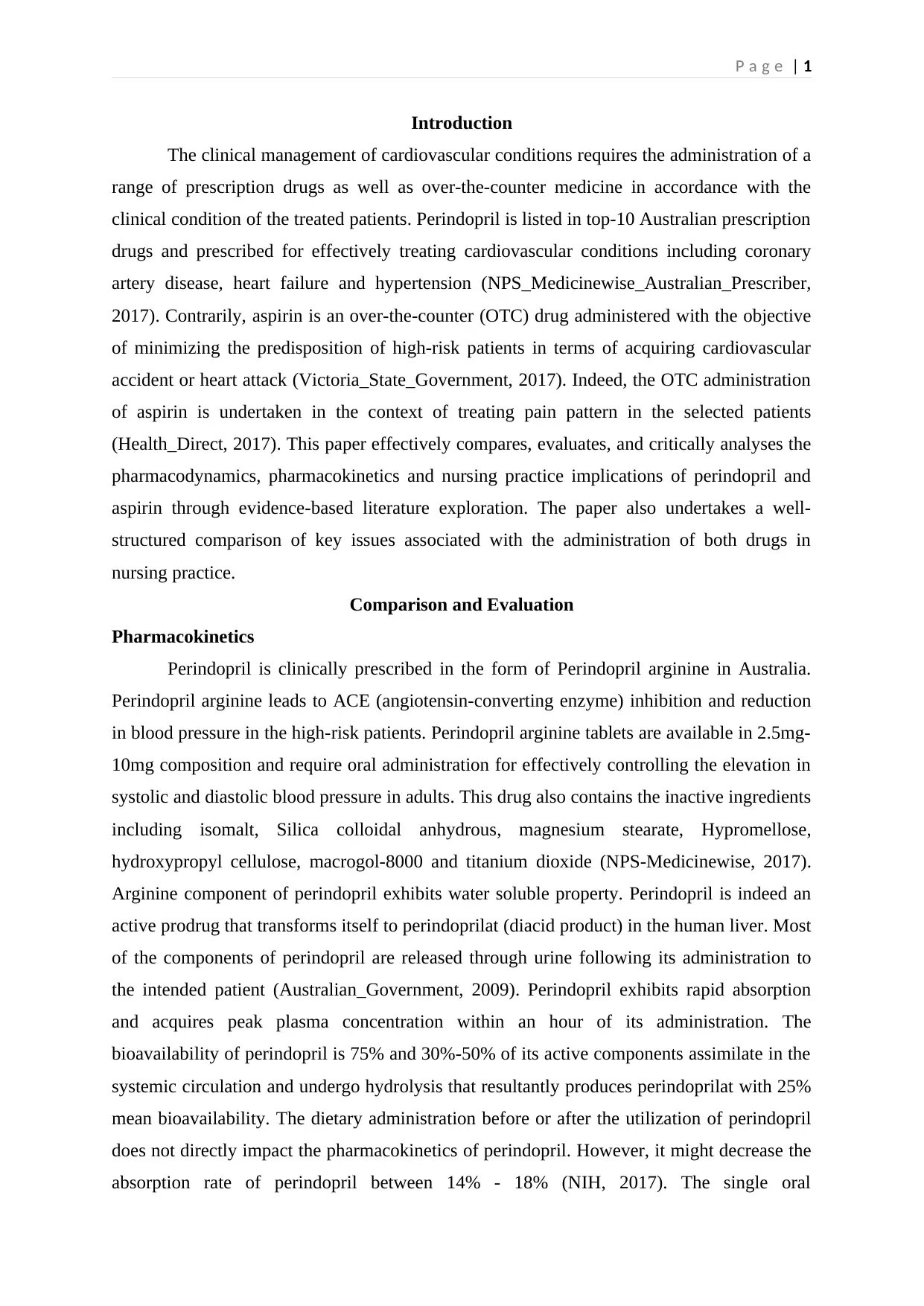
P a g e | 1
Introduction
The clinical management of cardiovascular conditions requires the administration of a
range of prescription drugs as well as over-the-counter medicine in accordance with the
clinical condition of the treated patients. Perindopril is listed in top-10 Australian prescription
drugs and prescribed for effectively treating cardiovascular conditions including coronary
artery disease, heart failure and hypertension (NPS_Medicinewise_Australian_Prescriber,
2017). Contrarily, aspirin is an over-the-counter (OTC) drug administered with the objective
of minimizing the predisposition of high-risk patients in terms of acquiring cardiovascular
accident or heart attack (Victoria_State_Government, 2017). Indeed, the OTC administration
of aspirin is undertaken in the context of treating pain pattern in the selected patients
(Health_Direct, 2017). This paper effectively compares, evaluates, and critically analyses the
pharmacodynamics, pharmacokinetics and nursing practice implications of perindopril and
aspirin through evidence-based literature exploration. The paper also undertakes a well-
structured comparison of key issues associated with the administration of both drugs in
nursing practice.
Comparison and Evaluation
Pharmacokinetics
Perindopril is clinically prescribed in the form of Perindopril arginine in Australia.
Perindopril arginine leads to ACE (angiotensin-converting enzyme) inhibition and reduction
in blood pressure in the high-risk patients. Perindopril arginine tablets are available in 2.5mg-
10mg composition and require oral administration for effectively controlling the elevation in
systolic and diastolic blood pressure in adults. This drug also contains the inactive ingredients
including isomalt, Silica colloidal anhydrous, magnesium stearate, Hypromellose,
hydroxypropyl cellulose, macrogol-8000 and titanium dioxide (NPS-Medicinewise, 2017).
Arginine component of perindopril exhibits water soluble property. Perindopril is indeed an
active prodrug that transforms itself to perindoprilat (diacid product) in the human liver. Most
of the components of perindopril are released through urine following its administration to
the intended patient (Australian_Government, 2009). Perindopril exhibits rapid absorption
and acquires peak plasma concentration within an hour of its administration. The
bioavailability of perindopril is 75% and 30%-50% of its active components assimilate in the
systemic circulation and undergo hydrolysis that resultantly produces perindoprilat with 25%
mean bioavailability. The dietary administration before or after the utilization of perindopril
does not directly impact the pharmacokinetics of perindopril. However, it might decrease the
absorption rate of perindopril between 14% - 18% (NIH, 2017). The single oral
Introduction
The clinical management of cardiovascular conditions requires the administration of a
range of prescription drugs as well as over-the-counter medicine in accordance with the
clinical condition of the treated patients. Perindopril is listed in top-10 Australian prescription
drugs and prescribed for effectively treating cardiovascular conditions including coronary
artery disease, heart failure and hypertension (NPS_Medicinewise_Australian_Prescriber,
2017). Contrarily, aspirin is an over-the-counter (OTC) drug administered with the objective
of minimizing the predisposition of high-risk patients in terms of acquiring cardiovascular
accident or heart attack (Victoria_State_Government, 2017). Indeed, the OTC administration
of aspirin is undertaken in the context of treating pain pattern in the selected patients
(Health_Direct, 2017). This paper effectively compares, evaluates, and critically analyses the
pharmacodynamics, pharmacokinetics and nursing practice implications of perindopril and
aspirin through evidence-based literature exploration. The paper also undertakes a well-
structured comparison of key issues associated with the administration of both drugs in
nursing practice.
Comparison and Evaluation
Pharmacokinetics
Perindopril is clinically prescribed in the form of Perindopril arginine in Australia.
Perindopril arginine leads to ACE (angiotensin-converting enzyme) inhibition and reduction
in blood pressure in the high-risk patients. Perindopril arginine tablets are available in 2.5mg-
10mg composition and require oral administration for effectively controlling the elevation in
systolic and diastolic blood pressure in adults. This drug also contains the inactive ingredients
including isomalt, Silica colloidal anhydrous, magnesium stearate, Hypromellose,
hydroxypropyl cellulose, macrogol-8000 and titanium dioxide (NPS-Medicinewise, 2017).
Arginine component of perindopril exhibits water soluble property. Perindopril is indeed an
active prodrug that transforms itself to perindoprilat (diacid product) in the human liver. Most
of the components of perindopril are released through urine following its administration to
the intended patient (Australian_Government, 2009). Perindopril exhibits rapid absorption
and acquires peak plasma concentration within an hour of its administration. The
bioavailability of perindopril is 75% and 30%-50% of its active components assimilate in the
systemic circulation and undergo hydrolysis that resultantly produces perindoprilat with 25%
mean bioavailability. The dietary administration before or after the utilization of perindopril
does not directly impact the pharmacokinetics of perindopril. However, it might decrease the
absorption rate of perindopril between 14% - 18% (NIH, 2017). The single oral
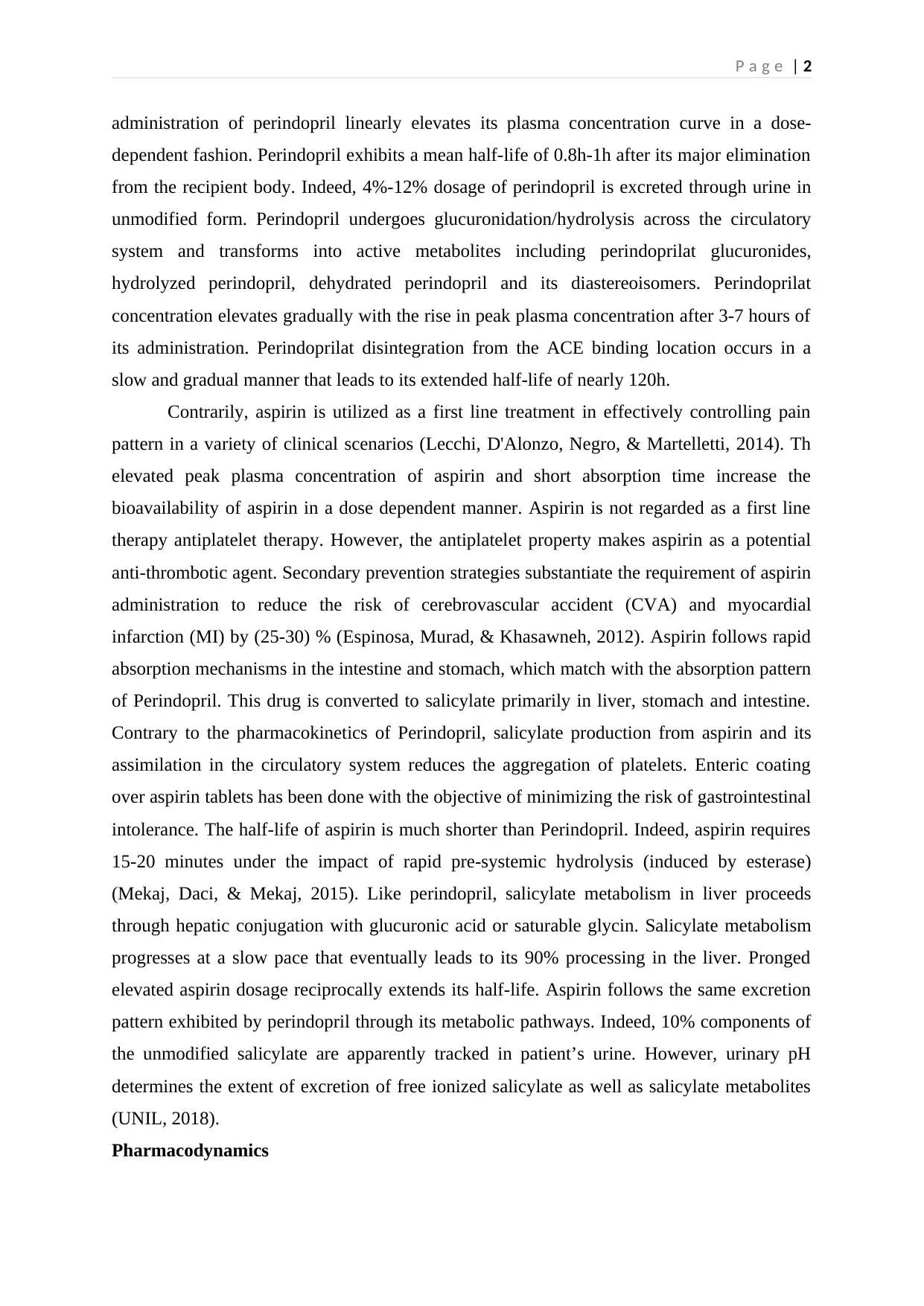
P a g e | 2
administration of perindopril linearly elevates its plasma concentration curve in a dose-
dependent fashion. Perindopril exhibits a mean half-life of 0.8h-1h after its major elimination
from the recipient body. Indeed, 4%-12% dosage of perindopril is excreted through urine in
unmodified form. Perindopril undergoes glucuronidation/hydrolysis across the circulatory
system and transforms into active metabolites including perindoprilat glucuronides,
hydrolyzed perindopril, dehydrated perindopril and its diastereoisomers. Perindoprilat
concentration elevates gradually with the rise in peak plasma concentration after 3-7 hours of
its administration. Perindoprilat disintegration from the ACE binding location occurs in a
slow and gradual manner that leads to its extended half-life of nearly 120h.
Contrarily, aspirin is utilized as a first line treatment in effectively controlling pain
pattern in a variety of clinical scenarios (Lecchi, D'Alonzo, Negro, & Martelletti, 2014). Th
elevated peak plasma concentration of aspirin and short absorption time increase the
bioavailability of aspirin in a dose dependent manner. Aspirin is not regarded as a first line
therapy antiplatelet therapy. However, the antiplatelet property makes aspirin as a potential
anti-thrombotic agent. Secondary prevention strategies substantiate the requirement of aspirin
administration to reduce the risk of cerebrovascular accident (CVA) and myocardial
infarction (MI) by (25-30) % (Espinosa, Murad, & Khasawneh, 2012). Aspirin follows rapid
absorption mechanisms in the intestine and stomach, which match with the absorption pattern
of Perindopril. This drug is converted to salicylate primarily in liver, stomach and intestine.
Contrary to the pharmacokinetics of Perindopril, salicylate production from aspirin and its
assimilation in the circulatory system reduces the aggregation of platelets. Enteric coating
over aspirin tablets has been done with the objective of minimizing the risk of gastrointestinal
intolerance. The half-life of aspirin is much shorter than Perindopril. Indeed, aspirin requires
15-20 minutes under the impact of rapid pre-systemic hydrolysis (induced by esterase)
(Mekaj, Daci, & Mekaj, 2015). Like perindopril, salicylate metabolism in liver proceeds
through hepatic conjugation with glucuronic acid or saturable glycin. Salicylate metabolism
progresses at a slow pace that eventually leads to its 90% processing in the liver. Pronged
elevated aspirin dosage reciprocally extends its half-life. Aspirin follows the same excretion
pattern exhibited by perindopril through its metabolic pathways. Indeed, 10% components of
the unmodified salicylate are apparently tracked in patient’s urine. However, urinary pH
determines the extent of excretion of free ionized salicylate as well as salicylate metabolites
(UNIL, 2018).
Pharmacodynamics
administration of perindopril linearly elevates its plasma concentration curve in a dose-
dependent fashion. Perindopril exhibits a mean half-life of 0.8h-1h after its major elimination
from the recipient body. Indeed, 4%-12% dosage of perindopril is excreted through urine in
unmodified form. Perindopril undergoes glucuronidation/hydrolysis across the circulatory
system and transforms into active metabolites including perindoprilat glucuronides,
hydrolyzed perindopril, dehydrated perindopril and its diastereoisomers. Perindoprilat
concentration elevates gradually with the rise in peak plasma concentration after 3-7 hours of
its administration. Perindoprilat disintegration from the ACE binding location occurs in a
slow and gradual manner that leads to its extended half-life of nearly 120h.
Contrarily, aspirin is utilized as a first line treatment in effectively controlling pain
pattern in a variety of clinical scenarios (Lecchi, D'Alonzo, Negro, & Martelletti, 2014). Th
elevated peak plasma concentration of aspirin and short absorption time increase the
bioavailability of aspirin in a dose dependent manner. Aspirin is not regarded as a first line
therapy antiplatelet therapy. However, the antiplatelet property makes aspirin as a potential
anti-thrombotic agent. Secondary prevention strategies substantiate the requirement of aspirin
administration to reduce the risk of cerebrovascular accident (CVA) and myocardial
infarction (MI) by (25-30) % (Espinosa, Murad, & Khasawneh, 2012). Aspirin follows rapid
absorption mechanisms in the intestine and stomach, which match with the absorption pattern
of Perindopril. This drug is converted to salicylate primarily in liver, stomach and intestine.
Contrary to the pharmacokinetics of Perindopril, salicylate production from aspirin and its
assimilation in the circulatory system reduces the aggregation of platelets. Enteric coating
over aspirin tablets has been done with the objective of minimizing the risk of gastrointestinal
intolerance. The half-life of aspirin is much shorter than Perindopril. Indeed, aspirin requires
15-20 minutes under the impact of rapid pre-systemic hydrolysis (induced by esterase)
(Mekaj, Daci, & Mekaj, 2015). Like perindopril, salicylate metabolism in liver proceeds
through hepatic conjugation with glucuronic acid or saturable glycin. Salicylate metabolism
progresses at a slow pace that eventually leads to its 90% processing in the liver. Pronged
elevated aspirin dosage reciprocally extends its half-life. Aspirin follows the same excretion
pattern exhibited by perindopril through its metabolic pathways. Indeed, 10% components of
the unmodified salicylate are apparently tracked in patient’s urine. However, urinary pH
determines the extent of excretion of free ionized salicylate as well as salicylate metabolites
(UNIL, 2018).
Pharmacodynamics
⊘ This is a preview!⊘
Do you want full access?
Subscribe today to unlock all pages.

Trusted by 1+ million students worldwide
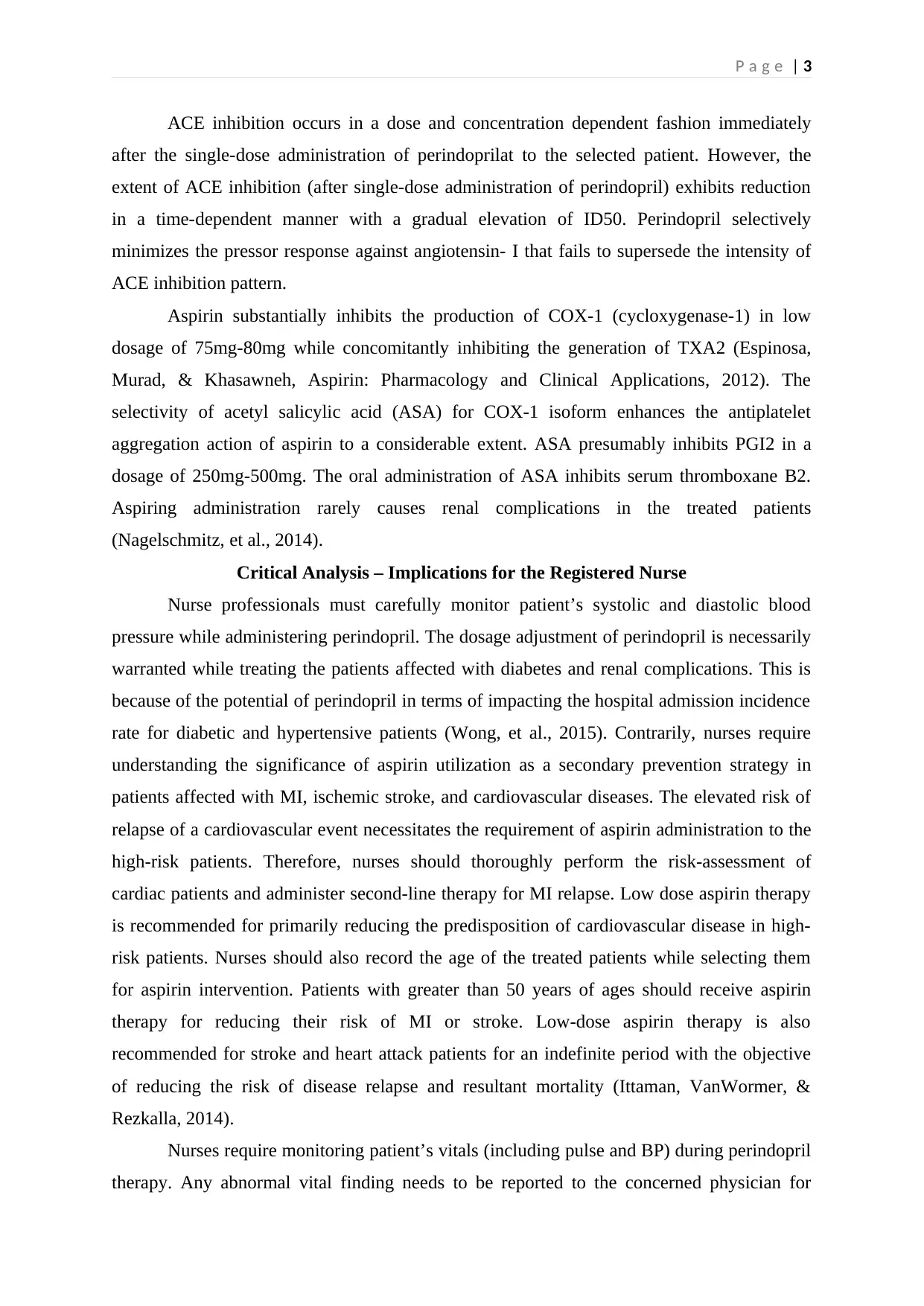
P a g e | 3
ACE inhibition occurs in a dose and concentration dependent fashion immediately
after the single-dose administration of perindoprilat to the selected patient. However, the
extent of ACE inhibition (after single-dose administration of perindopril) exhibits reduction
in a time-dependent manner with a gradual elevation of ID50. Perindopril selectively
minimizes the pressor response against angiotensin- I that fails to supersede the intensity of
ACE inhibition pattern.
Aspirin substantially inhibits the production of COX-1 (cycloxygenase-1) in low
dosage of 75mg-80mg while concomitantly inhibiting the generation of TXA2 (Espinosa,
Murad, & Khasawneh, Aspirin: Pharmacology and Clinical Applications, 2012). The
selectivity of acetyl salicylic acid (ASA) for COX-1 isoform enhances the antiplatelet
aggregation action of aspirin to a considerable extent. ASA presumably inhibits PGI2 in a
dosage of 250mg-500mg. The oral administration of ASA inhibits serum thromboxane B2.
Aspiring administration rarely causes renal complications in the treated patients
(Nagelschmitz, et al., 2014).
Critical Analysis – Implications for the Registered Nurse
Nurse professionals must carefully monitor patient’s systolic and diastolic blood
pressure while administering perindopril. The dosage adjustment of perindopril is necessarily
warranted while treating the patients affected with diabetes and renal complications. This is
because of the potential of perindopril in terms of impacting the hospital admission incidence
rate for diabetic and hypertensive patients (Wong, et al., 2015). Contrarily, nurses require
understanding the significance of aspirin utilization as a secondary prevention strategy in
patients affected with MI, ischemic stroke, and cardiovascular diseases. The elevated risk of
relapse of a cardiovascular event necessitates the requirement of aspirin administration to the
high-risk patients. Therefore, nurses should thoroughly perform the risk-assessment of
cardiac patients and administer second-line therapy for MI relapse. Low dose aspirin therapy
is recommended for primarily reducing the predisposition of cardiovascular disease in high-
risk patients. Nurses should also record the age of the treated patients while selecting them
for aspirin intervention. Patients with greater than 50 years of ages should receive aspirin
therapy for reducing their risk of MI or stroke. Low-dose aspirin therapy is also
recommended for stroke and heart attack patients for an indefinite period with the objective
of reducing the risk of disease relapse and resultant mortality (Ittaman, VanWormer, &
Rezkalla, 2014).
Nurses require monitoring patient’s vitals (including pulse and BP) during perindopril
therapy. Any abnormal vital finding needs to be reported to the concerned physician for
ACE inhibition occurs in a dose and concentration dependent fashion immediately
after the single-dose administration of perindoprilat to the selected patient. However, the
extent of ACE inhibition (after single-dose administration of perindopril) exhibits reduction
in a time-dependent manner with a gradual elevation of ID50. Perindopril selectively
minimizes the pressor response against angiotensin- I that fails to supersede the intensity of
ACE inhibition pattern.
Aspirin substantially inhibits the production of COX-1 (cycloxygenase-1) in low
dosage of 75mg-80mg while concomitantly inhibiting the generation of TXA2 (Espinosa,
Murad, & Khasawneh, Aspirin: Pharmacology and Clinical Applications, 2012). The
selectivity of acetyl salicylic acid (ASA) for COX-1 isoform enhances the antiplatelet
aggregation action of aspirin to a considerable extent. ASA presumably inhibits PGI2 in a
dosage of 250mg-500mg. The oral administration of ASA inhibits serum thromboxane B2.
Aspiring administration rarely causes renal complications in the treated patients
(Nagelschmitz, et al., 2014).
Critical Analysis – Implications for the Registered Nurse
Nurse professionals must carefully monitor patient’s systolic and diastolic blood
pressure while administering perindopril. The dosage adjustment of perindopril is necessarily
warranted while treating the patients affected with diabetes and renal complications. This is
because of the potential of perindopril in terms of impacting the hospital admission incidence
rate for diabetic and hypertensive patients (Wong, et al., 2015). Contrarily, nurses require
understanding the significance of aspirin utilization as a secondary prevention strategy in
patients affected with MI, ischemic stroke, and cardiovascular diseases. The elevated risk of
relapse of a cardiovascular event necessitates the requirement of aspirin administration to the
high-risk patients. Therefore, nurses should thoroughly perform the risk-assessment of
cardiac patients and administer second-line therapy for MI relapse. Low dose aspirin therapy
is recommended for primarily reducing the predisposition of cardiovascular disease in high-
risk patients. Nurses should also record the age of the treated patients while selecting them
for aspirin intervention. Patients with greater than 50 years of ages should receive aspirin
therapy for reducing their risk of MI or stroke. Low-dose aspirin therapy is also
recommended for stroke and heart attack patients for an indefinite period with the objective
of reducing the risk of disease relapse and resultant mortality (Ittaman, VanWormer, &
Rezkalla, 2014).
Nurses require monitoring patient’s vitals (including pulse and BP) during perindopril
therapy. Any abnormal vital finding needs to be reported to the concerned physician for
Paraphrase This Document
Need a fresh take? Get an instant paraphrase of this document with our AI Paraphraser
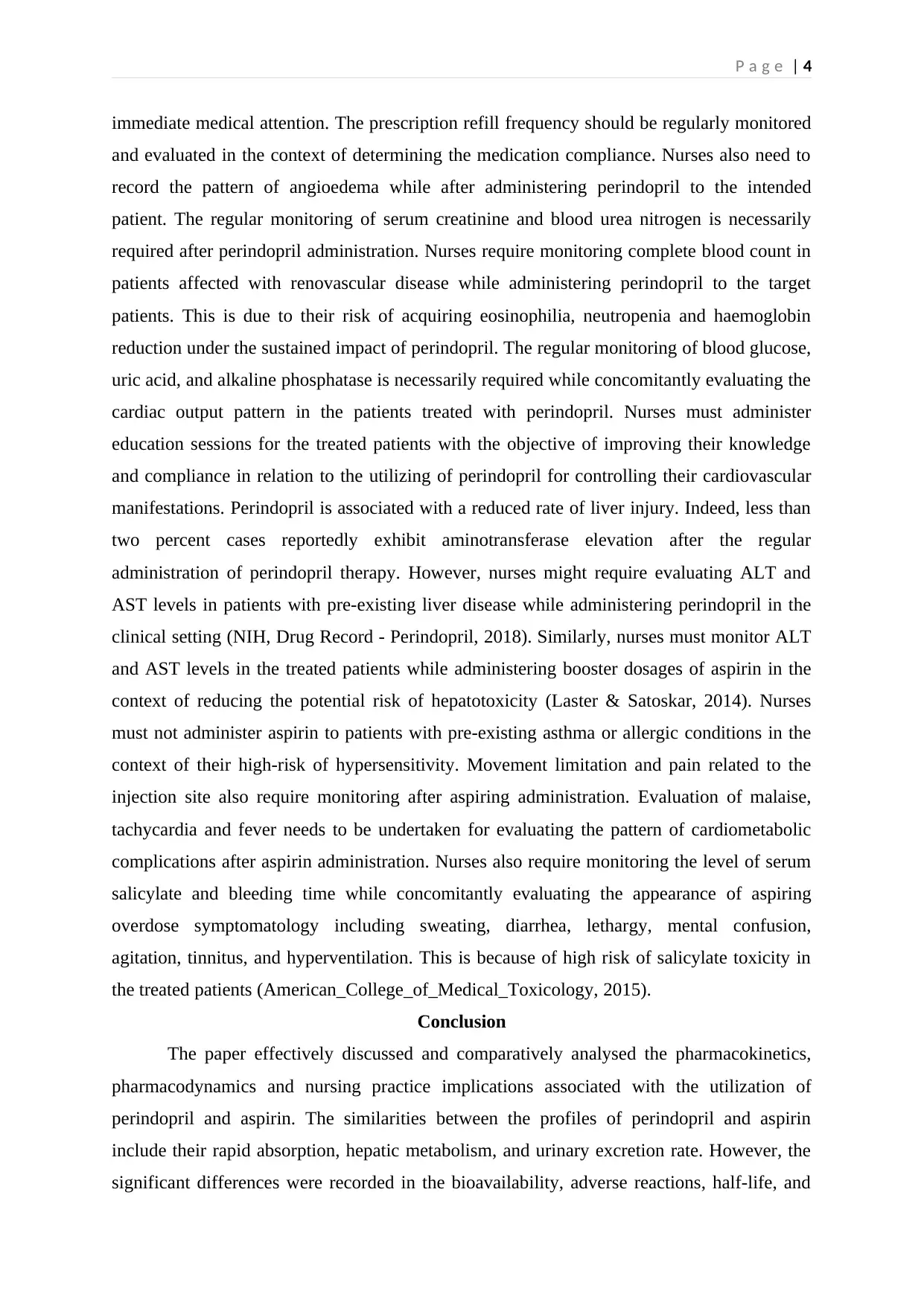
P a g e | 4
immediate medical attention. The prescription refill frequency should be regularly monitored
and evaluated in the context of determining the medication compliance. Nurses also need to
record the pattern of angioedema while after administering perindopril to the intended
patient. The regular monitoring of serum creatinine and blood urea nitrogen is necessarily
required after perindopril administration. Nurses require monitoring complete blood count in
patients affected with renovascular disease while administering perindopril to the target
patients. This is due to their risk of acquiring eosinophilia, neutropenia and haemoglobin
reduction under the sustained impact of perindopril. The regular monitoring of blood glucose,
uric acid, and alkaline phosphatase is necessarily required while concomitantly evaluating the
cardiac output pattern in the patients treated with perindopril. Nurses must administer
education sessions for the treated patients with the objective of improving their knowledge
and compliance in relation to the utilizing of perindopril for controlling their cardiovascular
manifestations. Perindopril is associated with a reduced rate of liver injury. Indeed, less than
two percent cases reportedly exhibit aminotransferase elevation after the regular
administration of perindopril therapy. However, nurses might require evaluating ALT and
AST levels in patients with pre-existing liver disease while administering perindopril in the
clinical setting (NIH, Drug Record - Perindopril, 2018). Similarly, nurses must monitor ALT
and AST levels in the treated patients while administering booster dosages of aspirin in the
context of reducing the potential risk of hepatotoxicity (Laster & Satoskar, 2014). Nurses
must not administer aspirin to patients with pre-existing asthma or allergic conditions in the
context of their high-risk of hypersensitivity. Movement limitation and pain related to the
injection site also require monitoring after aspiring administration. Evaluation of malaise,
tachycardia and fever needs to be undertaken for evaluating the pattern of cardiometabolic
complications after aspirin administration. Nurses also require monitoring the level of serum
salicylate and bleeding time while concomitantly evaluating the appearance of aspiring
overdose symptomatology including sweating, diarrhea, lethargy, mental confusion,
agitation, tinnitus, and hyperventilation. This is because of high risk of salicylate toxicity in
the treated patients (American_College_of_Medical_Toxicology, 2015).
Conclusion
The paper effectively discussed and comparatively analysed the pharmacokinetics,
pharmacodynamics and nursing practice implications associated with the utilization of
perindopril and aspirin. The similarities between the profiles of perindopril and aspirin
include their rapid absorption, hepatic metabolism, and urinary excretion rate. However, the
significant differences were recorded in the bioavailability, adverse reactions, half-life, and
immediate medical attention. The prescription refill frequency should be regularly monitored
and evaluated in the context of determining the medication compliance. Nurses also need to
record the pattern of angioedema while after administering perindopril to the intended
patient. The regular monitoring of serum creatinine and blood urea nitrogen is necessarily
required after perindopril administration. Nurses require monitoring complete blood count in
patients affected with renovascular disease while administering perindopril to the target
patients. This is due to their risk of acquiring eosinophilia, neutropenia and haemoglobin
reduction under the sustained impact of perindopril. The regular monitoring of blood glucose,
uric acid, and alkaline phosphatase is necessarily required while concomitantly evaluating the
cardiac output pattern in the patients treated with perindopril. Nurses must administer
education sessions for the treated patients with the objective of improving their knowledge
and compliance in relation to the utilizing of perindopril for controlling their cardiovascular
manifestations. Perindopril is associated with a reduced rate of liver injury. Indeed, less than
two percent cases reportedly exhibit aminotransferase elevation after the regular
administration of perindopril therapy. However, nurses might require evaluating ALT and
AST levels in patients with pre-existing liver disease while administering perindopril in the
clinical setting (NIH, Drug Record - Perindopril, 2018). Similarly, nurses must monitor ALT
and AST levels in the treated patients while administering booster dosages of aspirin in the
context of reducing the potential risk of hepatotoxicity (Laster & Satoskar, 2014). Nurses
must not administer aspirin to patients with pre-existing asthma or allergic conditions in the
context of their high-risk of hypersensitivity. Movement limitation and pain related to the
injection site also require monitoring after aspiring administration. Evaluation of malaise,
tachycardia and fever needs to be undertaken for evaluating the pattern of cardiometabolic
complications after aspirin administration. Nurses also require monitoring the level of serum
salicylate and bleeding time while concomitantly evaluating the appearance of aspiring
overdose symptomatology including sweating, diarrhea, lethargy, mental confusion,
agitation, tinnitus, and hyperventilation. This is because of high risk of salicylate toxicity in
the treated patients (American_College_of_Medical_Toxicology, 2015).
Conclusion
The paper effectively discussed and comparatively analysed the pharmacokinetics,
pharmacodynamics and nursing practice implications associated with the utilization of
perindopril and aspirin. The similarities between the profiles of perindopril and aspirin
include their rapid absorption, hepatic metabolism, and urinary excretion rate. However, the
significant differences were recorded in the bioavailability, adverse reactions, half-life, and

P a g e | 5
prescription status of both drugs. Systematic monitoring of patient symptomatology and
laboratory evaluation are necessarily required with the objective of minimizing the risk of
potential clinical complications following the administration of perindopril or aspirin to the
selected patients.
prescription status of both drugs. Systematic monitoring of patient symptomatology and
laboratory evaluation are necessarily required with the objective of minimizing the risk of
potential clinical complications following the administration of perindopril or aspirin to the
selected patients.
⊘ This is a preview!⊘
Do you want full access?
Subscribe today to unlock all pages.

Trusted by 1+ million students worldwide
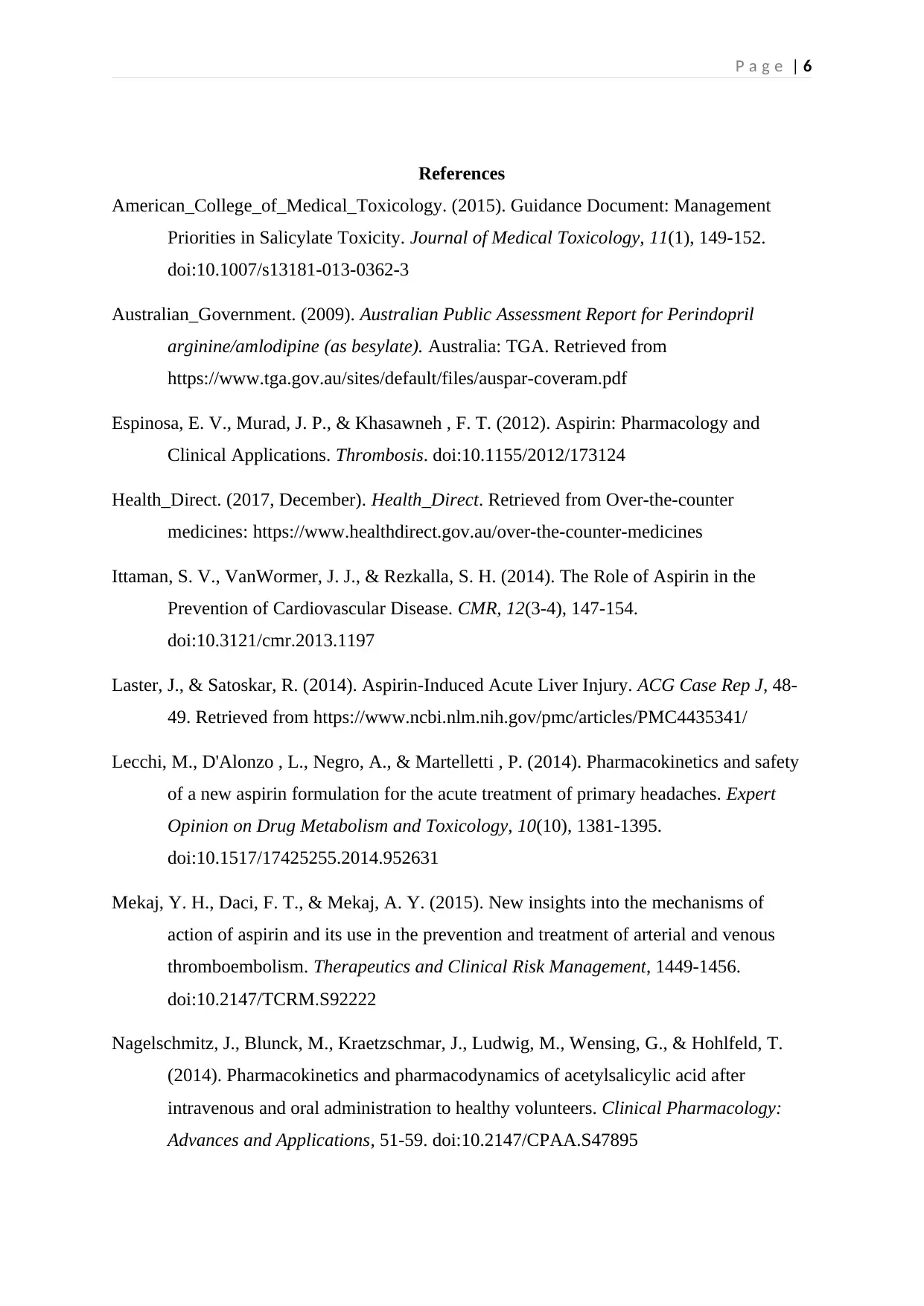
P a g e | 6
References
American_College_of_Medical_Toxicology. (2015). Guidance Document: Management
Priorities in Salicylate Toxicity. Journal of Medical Toxicology, 11(1), 149-152.
doi:10.1007/s13181-013-0362-3
Australian_Government. (2009). Australian Public Assessment Report for Perindopril
arginine/amlodipine (as besylate). Australia: TGA. Retrieved from
https://www.tga.gov.au/sites/default/files/auspar-coveram.pdf
Espinosa, E. V., Murad, J. P., & Khasawneh , F. T. (2012). Aspirin: Pharmacology and
Clinical Applications. Thrombosis. doi:10.1155/2012/173124
Health_Direct. (2017, December). Health_Direct. Retrieved from Over-the-counter
medicines: https://www.healthdirect.gov.au/over-the-counter-medicines
Ittaman, S. V., VanWormer, J. J., & Rezkalla, S. H. (2014). The Role of Aspirin in the
Prevention of Cardiovascular Disease. CMR, 12(3-4), 147-154.
doi:10.3121/cmr.2013.1197
Laster, J., & Satoskar, R. (2014). Aspirin-Induced Acute Liver Injury. ACG Case Rep J, 48-
49. Retrieved from https://www.ncbi.nlm.nih.gov/pmc/articles/PMC4435341/
Lecchi, M., D'Alonzo , L., Negro, A., & Martelletti , P. (2014). Pharmacokinetics and safety
of a new aspirin formulation for the acute treatment of primary headaches. Expert
Opinion on Drug Metabolism and Toxicology, 10(10), 1381-1395.
doi:10.1517/17425255.2014.952631
Mekaj, Y. H., Daci, F. T., & Mekaj, A. Y. (2015). New insights into the mechanisms of
action of aspirin and its use in the prevention and treatment of arterial and venous
thromboembolism. Therapeutics and Clinical Risk Management, 1449-1456.
doi:10.2147/TCRM.S92222
Nagelschmitz, J., Blunck, M., Kraetzschmar, J., Ludwig, M., Wensing, G., & Hohlfeld, T.
(2014). Pharmacokinetics and pharmacodynamics of acetylsalicylic acid after
intravenous and oral administration to healthy volunteers. Clinical Pharmacology:
Advances and Applications, 51-59. doi:10.2147/CPAA.S47895
References
American_College_of_Medical_Toxicology. (2015). Guidance Document: Management
Priorities in Salicylate Toxicity. Journal of Medical Toxicology, 11(1), 149-152.
doi:10.1007/s13181-013-0362-3
Australian_Government. (2009). Australian Public Assessment Report for Perindopril
arginine/amlodipine (as besylate). Australia: TGA. Retrieved from
https://www.tga.gov.au/sites/default/files/auspar-coveram.pdf
Espinosa, E. V., Murad, J. P., & Khasawneh , F. T. (2012). Aspirin: Pharmacology and
Clinical Applications. Thrombosis. doi:10.1155/2012/173124
Health_Direct. (2017, December). Health_Direct. Retrieved from Over-the-counter
medicines: https://www.healthdirect.gov.au/over-the-counter-medicines
Ittaman, S. V., VanWormer, J. J., & Rezkalla, S. H. (2014). The Role of Aspirin in the
Prevention of Cardiovascular Disease. CMR, 12(3-4), 147-154.
doi:10.3121/cmr.2013.1197
Laster, J., & Satoskar, R. (2014). Aspirin-Induced Acute Liver Injury. ACG Case Rep J, 48-
49. Retrieved from https://www.ncbi.nlm.nih.gov/pmc/articles/PMC4435341/
Lecchi, M., D'Alonzo , L., Negro, A., & Martelletti , P. (2014). Pharmacokinetics and safety
of a new aspirin formulation for the acute treatment of primary headaches. Expert
Opinion on Drug Metabolism and Toxicology, 10(10), 1381-1395.
doi:10.1517/17425255.2014.952631
Mekaj, Y. H., Daci, F. T., & Mekaj, A. Y. (2015). New insights into the mechanisms of
action of aspirin and its use in the prevention and treatment of arterial and venous
thromboembolism. Therapeutics and Clinical Risk Management, 1449-1456.
doi:10.2147/TCRM.S92222
Nagelschmitz, J., Blunck, M., Kraetzschmar, J., Ludwig, M., Wensing, G., & Hohlfeld, T.
(2014). Pharmacokinetics and pharmacodynamics of acetylsalicylic acid after
intravenous and oral administration to healthy volunteers. Clinical Pharmacology:
Advances and Applications, 51-59. doi:10.2147/CPAA.S47895
Paraphrase This Document
Need a fresh take? Get an instant paraphrase of this document with our AI Paraphraser
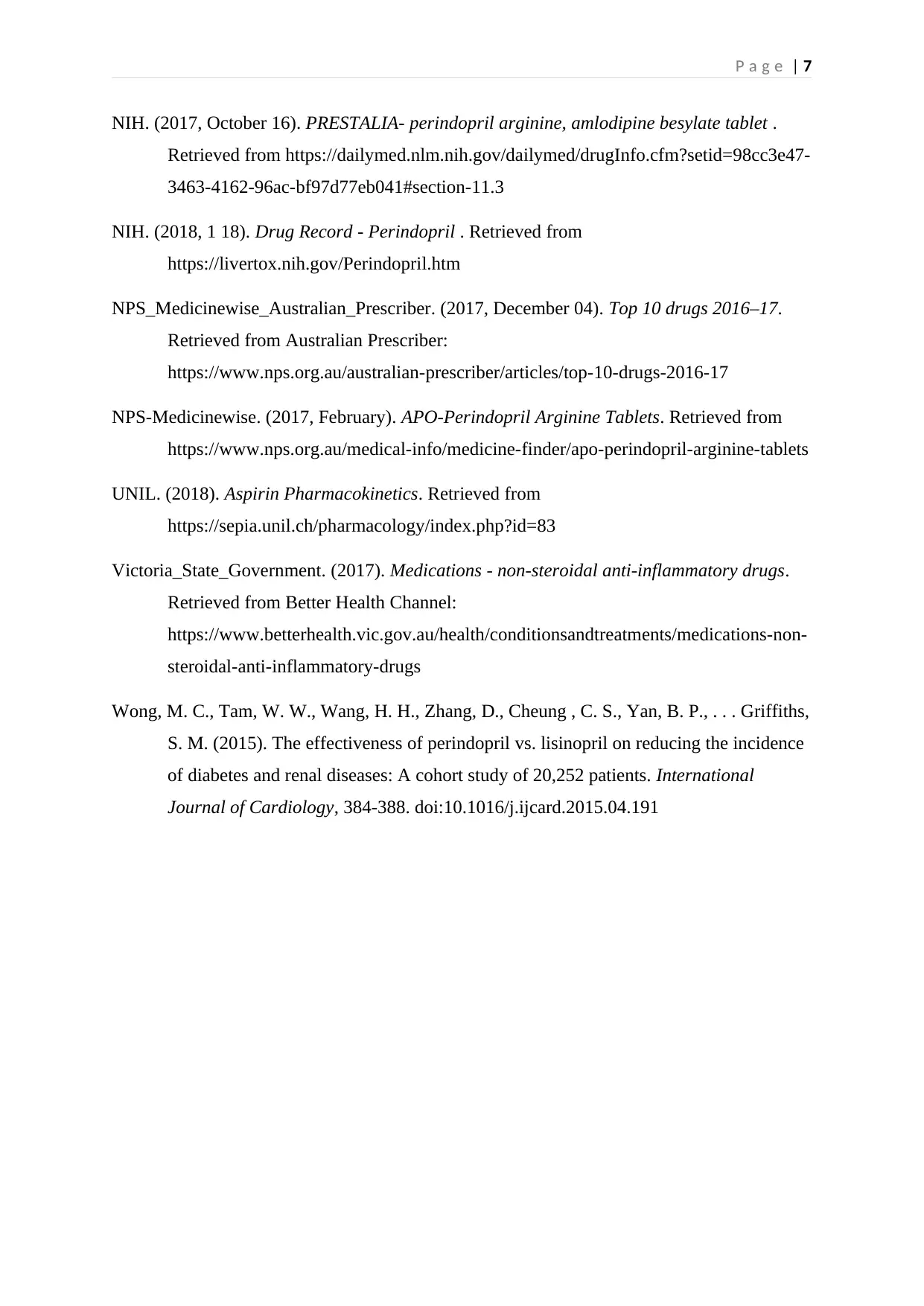
P a g e | 7
NIH. (2017, October 16). PRESTALIA- perindopril arginine, amlodipine besylate tablet .
Retrieved from https://dailymed.nlm.nih.gov/dailymed/drugInfo.cfm?setid=98cc3e47-
3463-4162-96ac-bf97d77eb041#section-11.3
NIH. (2018, 1 18). Drug Record - Perindopril . Retrieved from
https://livertox.nih.gov/Perindopril.htm
NPS_Medicinewise_Australian_Prescriber. (2017, December 04). Top 10 drugs 2016–17.
Retrieved from Australian Prescriber:
https://www.nps.org.au/australian-prescriber/articles/top-10-drugs-2016-17
NPS-Medicinewise. (2017, February). APO-Perindopril Arginine Tablets. Retrieved from
https://www.nps.org.au/medical-info/medicine-finder/apo-perindopril-arginine-tablets
UNIL. (2018). Aspirin Pharmacokinetics. Retrieved from
https://sepia.unil.ch/pharmacology/index.php?id=83
Victoria_State_Government. (2017). Medications - non-steroidal anti-inflammatory drugs.
Retrieved from Better Health Channel:
https://www.betterhealth.vic.gov.au/health/conditionsandtreatments/medications-non-
steroidal-anti-inflammatory-drugs
Wong, M. C., Tam, W. W., Wang, H. H., Zhang, D., Cheung , C. S., Yan, B. P., . . . Griffiths,
S. M. (2015). The effectiveness of perindopril vs. lisinopril on reducing the incidence
of diabetes and renal diseases: A cohort study of 20,252 patients. International
Journal of Cardiology, 384-388. doi:10.1016/j.ijcard.2015.04.191
NIH. (2017, October 16). PRESTALIA- perindopril arginine, amlodipine besylate tablet .
Retrieved from https://dailymed.nlm.nih.gov/dailymed/drugInfo.cfm?setid=98cc3e47-
3463-4162-96ac-bf97d77eb041#section-11.3
NIH. (2018, 1 18). Drug Record - Perindopril . Retrieved from
https://livertox.nih.gov/Perindopril.htm
NPS_Medicinewise_Australian_Prescriber. (2017, December 04). Top 10 drugs 2016–17.
Retrieved from Australian Prescriber:
https://www.nps.org.au/australian-prescriber/articles/top-10-drugs-2016-17
NPS-Medicinewise. (2017, February). APO-Perindopril Arginine Tablets. Retrieved from
https://www.nps.org.au/medical-info/medicine-finder/apo-perindopril-arginine-tablets
UNIL. (2018). Aspirin Pharmacokinetics. Retrieved from
https://sepia.unil.ch/pharmacology/index.php?id=83
Victoria_State_Government. (2017). Medications - non-steroidal anti-inflammatory drugs.
Retrieved from Better Health Channel:
https://www.betterhealth.vic.gov.au/health/conditionsandtreatments/medications-non-
steroidal-anti-inflammatory-drugs
Wong, M. C., Tam, W. W., Wang, H. H., Zhang, D., Cheung , C. S., Yan, B. P., . . . Griffiths,
S. M. (2015). The effectiveness of perindopril vs. lisinopril on reducing the incidence
of diabetes and renal diseases: A cohort study of 20,252 patients. International
Journal of Cardiology, 384-388. doi:10.1016/j.ijcard.2015.04.191
1 out of 8
Your All-in-One AI-Powered Toolkit for Academic Success.
+13062052269
info@desklib.com
Available 24*7 on WhatsApp / Email
![[object Object]](/_next/static/media/star-bottom.7253800d.svg)
Unlock your academic potential
Copyright © 2020–2025 A2Z Services. All Rights Reserved. Developed and managed by ZUCOL.

